

6 Filmmaking Tips from Jean-Luc Godard. Les Films Imperia.
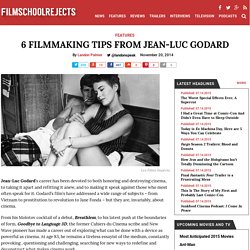
Attention, Filmmakers: Here's 12 Tips for Directing Your. By Justin Schwarz | Indiewire November 4, 2014 at 9:00AM Thinking of making your first feature film?
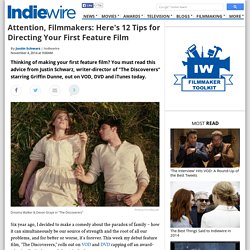
You must read this advice from Justin Schwarz, writer-director of "The Discoverers" starring Griffin Dunne, out on VOD, DVD and iTunes today. Legally Speaking, It Depends: Short Film Woes and Worries. Christopher Schiller is a NY transactional entertainment attorney who counts many independent filmmakers and writers among his diverse client base.

Follow Chris on Twitter @chrisschiller. Click to tweet this article to your friends and followers! Short films are easy, right? I mean, they’re just like the real thing only shorter, cheaper. Nothing could be further from the truth. Begin before you begin. 7 Tips to Shoot Like an Editor. After the five things cinematographers can do to make their editor happier, and the art of shooting B-Roll, another way to ensure that the transition between production and post-production is as smooth as possible is to think like an editor while you shoot.

DSLR Video Shooter gives out 7 tips to help you nail that mindset in their videos. 7 Tips to Shoot Like an Editor 1 – Film Transitional Shots. The 5 Locations Low-Budget Films Should Avoid In New York. Every week, I receive numerous requests from no/low budget filmmakers in search of New York City locations for cheap.

Some I can help with; most, I simply don’t know where to begin. While it’s certainly possible to make low-budget films in New York, it often requires a personal connection to secure those more difficult locations for an affordable price (friends and family! Friends and family!). The Art of Shooting B-Roll: Where to Start to Make Sure You'll Get What You Need. If you ever had to shoot a video for a client, whether a documentary or a more corporate one, there is one thing you probably quickly realized: B-Roll is key and getting good to great B-Roll is as important is it can be tricky.
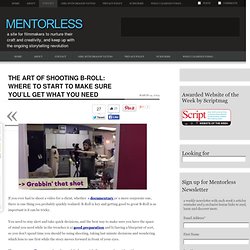
You need to stay alert and take quick decisions, and the best way to make sure you have the space of mind you need while in the trenches is a) good preparation and b) having a blueprint of sort, so you don’t spend time you should be using shooting, taking last minute decisions and wondering which lens to use first while the story moves forward in front of your eyes. The team over at Transom shared one of the best article I’ve seen so far, with a video you can watch below showing you step by step how to proceed, what to do, what not to do (which is sometimes as important as its counterpart) and how to do it to make sure you get enough B-Roll, and the best kind possible during a shooting day. [Thanks to No Film School] *********************For Story Makers: Donate. Film Studies 101: The 30 Camera Shots Every Film Fan Needs To Know. Attention, Filmmakers: Here’s How to Choose the Right Lens. Join To Bookmark Share Noam Kroll explains which lenses to use for which production — highlighting the benefits and drawbacks of primes (lenses with a fixed focal length) and zooms (which allow various vocal lengths).
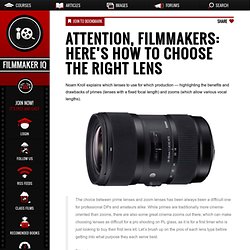
The choice between prime lenses and zoom lenses has been always been a difficult one for professional DPs and amateurs alike. While primes are traditionally more cinema-oriented than zooms, there are also some great cinema zooms out there, which can make choosing lenses as difficult for a pro shooting on PL glass, as it is for a first timer who is just looking to buy their first lens kit. Let’s brush up on the pros of each lens type before getting into what purpose they each serve best.Prime LensesFixed focal length lenses offer a very traditional way of shooting. January 28, 2014 Link No Comments Related Posts Leave a Reply. Video production class weblog: Day 0, 2014. On the evening before this year's interim video production class begins, I am, as usual, wondering if I'm ready.
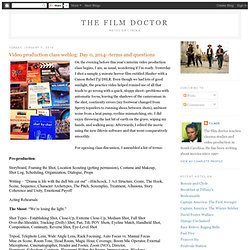
Yesterday I shot a sample 5 minute horror film entitled Slasher with a Canon Rebel T3i DSLR. Even though we had lots of good sunlight, the practice video helped remind me of all that tends to go wrong with a quick, sloppy shoot--problems with automatic focus, leaving the shadows of the cameraman in the shot, continuity errors (my footwear changed from Sperry topsiders to running shoes between shots), ambient noise from a heat pump, eyeline mismatching, etc.
I did enjoy throwing the last bit of earth on the grave, wiping my hands, and walking away. Afterwards, I edited the movie using the new iMovie software and that went comparatively smoothly. Writers On The Web: Pre-Production - Film Budgeting in Reverse. The Money Trap – don’t step in it!
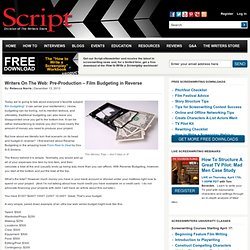
Today we’re going to talk about everyone’s favorite subject: film budgeting! (I can sense your excitement.) WHAT DOES IT MEAN TO CONFORM THE NEGATIVE ON A FILM? For the first time feature filmmaker, understanding post production can be a bit overwhelming.

Once a picture is “locked”, meaning the offline editing process is completely finished and no further changes will be made to the project, a film then needs to then be conformed. During this process, also called the online edit, the proxies or lower-resolution files that an editor worked with in the FCP/Avid/Premiere project are replaced with the original camera negative digital files. This workflow is necessary in order to maintain the best image quality possible on your film. A Beginner's Guide to Drone Filmmaking: 5 Steps.
The shots of New York, Berlin and other cities from above, the slow motion poetic explorations of summer afternoons, the panoramic aerial glimpses of Burning Man... they're gorgeous, and they're all made possible with the help of tiny cameras attached to unmanned aerial vehicles (UAVs) or drones, specifically a breed of quadcopters that include the popular DJI Phantom but that also count a number of DIY types amongst the ranks. (If you haven't seen any of these, check out our introduction to drone filmmaking videos). A few weeks ago, the people at DSLRPros.com loaned to me their Ultimate Cinema Edition Aerial Kit. I took it out a few times. First, to get acquainted with the machine, and then to record some of the aerial shots I was able to get. Here's the kit. Step 1: Figure out how you're getting up in the air.
How Camera Height Can Impact and Improve Your Film Aesthetic. At what height is the camera? To continue on working on the freelancing side of our job that involves dealing with clients, breaking down the different steps from pre-production to production, and shooting interviews, this week is about improving your film aesthetic. For Aviv Vana, cinematographer and creator of Big League Film School, an effective way to improve your film aesthetic is by choosing your camera height thoughtfully.
David Lowery On Going From a $12k First Feature to Ain't Them Bodies Saints - mentorless. Yesterday I had the chance to watch on a big big screen Ain’t Them Bodies Saints, the second feature film written & directed by David Lowery, and it was a feast for my eyes and mirror neurons. 5 Things First-Time Directors Aren’t Told. If there's anything that's even harder than making a movie, it's making your first movie. All week long, we've been sharing words of hard-won wisdom given to us by some of the veterans of the industry, but what about the first-time filmmakers who've miraculously managed to mount a movie despite overwhelming odds (and underwhelming budgets)?
For their perspective, we talked to John Krokidas, whose first film, Kill Your Darlings, stars Daniel Radcliffe and Dane DeHaan in the true story of the murder that brought Beat icons Allen Ginsberg, Jack Kerouac, and William S. Burroughs together as young men. Here, Krokidas shares the five unexpected things he learned on his directorial debut: The way that independent films are generally put together is that an investor sells off foreign territories before you even shoot the film, and just off of the actors' names, they actually sell the movie to various distributors around the world before anyone has even seen a frame of the movie.
10 Cheap Tools Every Filmmaker Needs. When you ask most filmmakers what their next purchase is, you’ll like hear an answer like “A new camera body, some lenses and better audio gear”. It’s always easy (and fun) to lust over new and expensive gear, but often we forget to buy the little things that make our life on set much less stressful. Although these tools are extremely affordable, they will often be the ones that make you a hero on set. Here are some tools that every filmmaker should have in their gear bag: Swiss Army Knife - This seems like a no brainer, but I often hear someone yell “Does anyone have scissors” or “I need a “Phillips head screwdriver” while on set. Keeping this simple tool in your kit can save valuable time and make you a hero. Just remember to remove it from your kit when when traveling on a plane. Magic Arm – A simple and effective way to attach gear to your camera at any angle. An Overview of the Game Changing Audio Recorder Zoom H4n.
Top 10 Tips To Raise Money For Your Documentary. Photo © aresauburn on flickr. 7 Tips from Silicon Valley on Giving Confidence to Potential Investors. Silicon Valley from above Flickr User Patrick Nouhailler. Creating a Level of Intensity with Internal Camera Settings. Shutter angle is an important story-telling tool. As a Director of Photography, I love this technique and wanted to show you how I have used it to assist in the character’s emotional arc. “Using this Technique to Assist the Story” Shutter angle in film and shutter speed in digital can be very powerful tools to assist in putting the viewer in a unique scene, creating visual tension, and creating an immersive feeling. Tutorials & Tips From Ryan E. Walters. Adding in film grain and applying film LUTs are a few of the tricks I've used over the years to take the edge off digital imagery.
The addition of these elements not only makes the image look and feel more like film, but, more importantly, it takes the "exactness" and clinical precision off of the digital image. Want to Get Your Film Into Sundance? The Festival’s Programmers Reveal Secrets to Successful Submissions. An Overview of the Zoom H6. My Go To Lighting Package Part Two: The Basics. To Shoot Better Video, Focus on Photography. To Shoot Better Video, Focus on Photography. Produce Your Best Ever HD-SLR Video—6 key areas to consider. “The use of D-SLR cameras for professional movie and film capture has taken off like wild fire. DSLR crew of 2 and budget of £500... what can be achieved? Jaw dropping work...
The Importance of Depth of Frame. How To Create Bizarre Slit Scan Video using After Effects. If you’ve watched the other video in this course, you learned that slit scan photography was used extensively at the race tracks to determine the winner in close contests. This is because slitscan photography is record not of spatial relationships but of temporal relationships – with lines recorded at different times composing the picture. Creating these time shifted images can lead to some bizarre and otherworldly visual effects. Advantages Of Using Stock Footage. Build Your Own Film/Video Rig This Weekend. Build Your Own Film/Video Rig This Weekend. A Beautiful DIY Stabalizer Making Of Video. Build a DIY Zoetrope.
Negative Space. Wisdom Wednesday: Wim Wenders' 50 (that's right, 50) Golden Rules of Moviemaking by Wim Wenders. Breaking the Fourth Wall: an Homage to a Storytelling Technique.